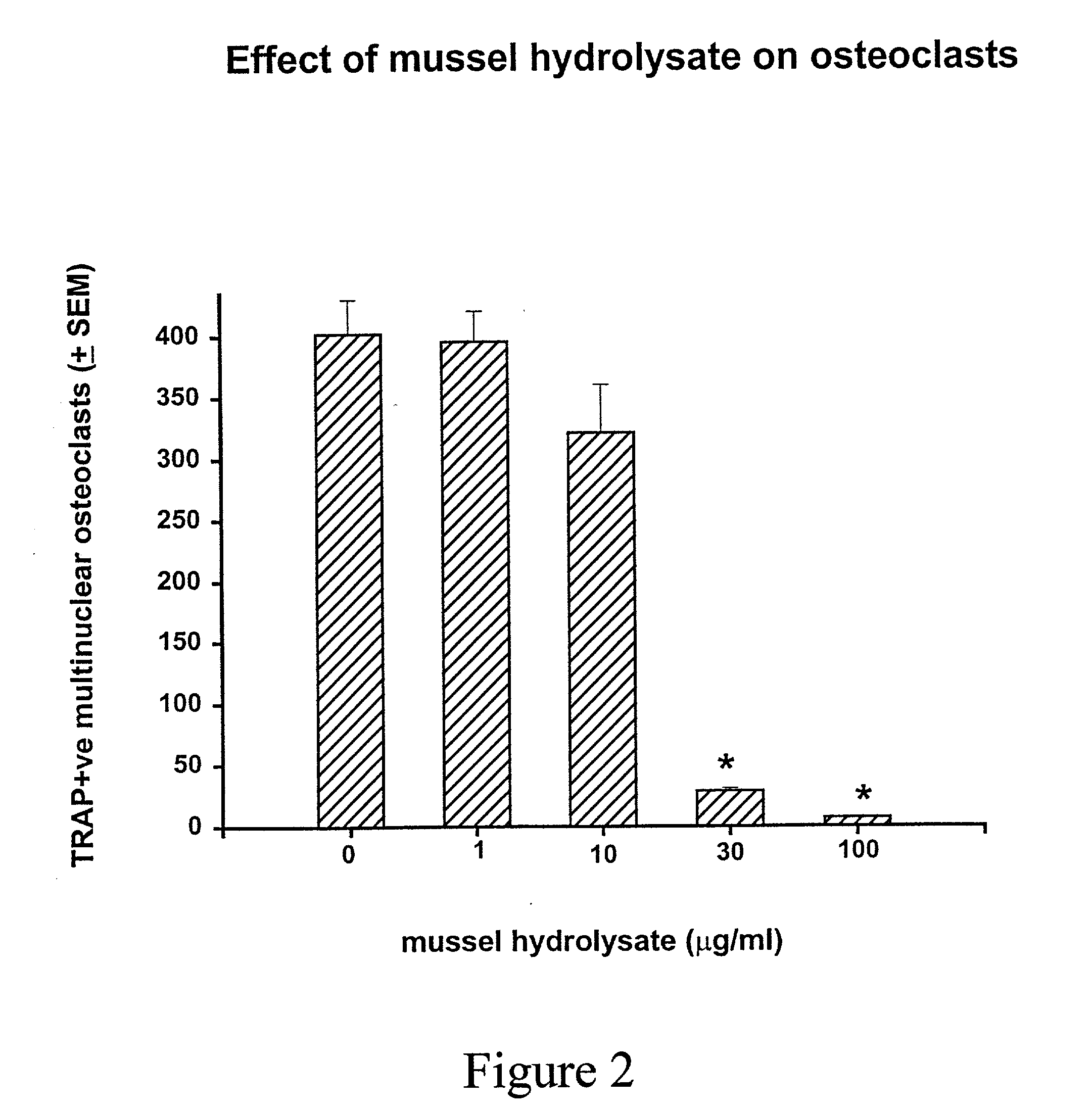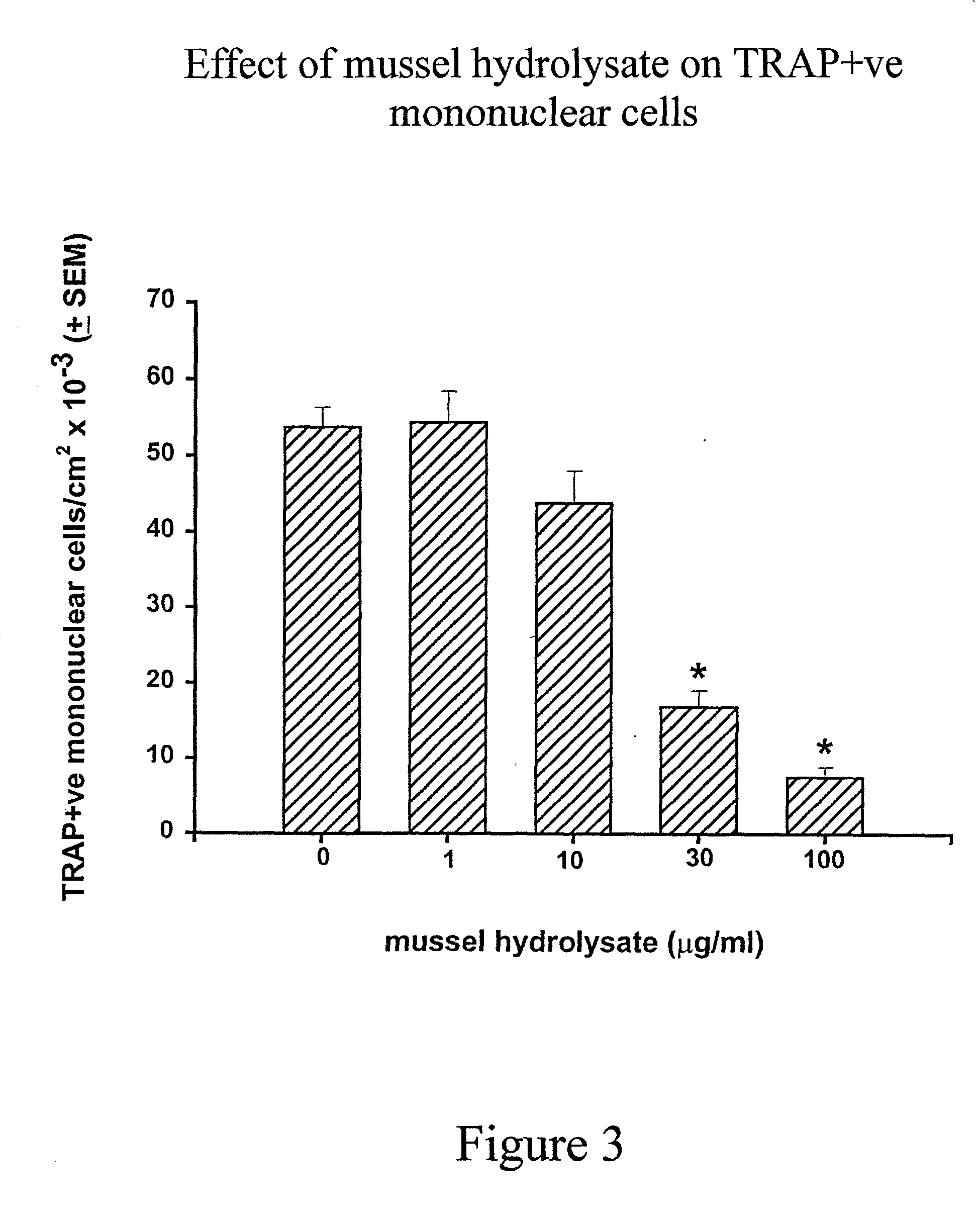Pharmaceutical composition useful for inhibition of osteoclast formation and a process for the extraction of mussel hudrolysate from indian green mussel
a technology of indian green mussel and hudrolysate, which is applied in the direction of pharmaceutical active ingredients, fermentation, unknown materials, etc., can solve the problems of excessive bone loss, osteoblast formation, and skeletal abnormalities characterized by increased or decreased bone mass, and achieve the effect of inhibiting osteoblast formation and inhibiting bone resorption
- Summary
- Abstract
- Description
- Claims
- Application Information
AI Technical Summary
Benefits of technology
Problems solved by technology
Method used
Image
Examples
example 1
In vitro Method for Inhibition of Osteoclast Formation and Bone Resorption Using Mussel Hydrolysate Comprising
[0055] (i) Effect of Mussel Hydrolysate on in vitro Osteoclastogenesis
[0056] Balb / c mice were sacrificed by cervical dislocation and bone marrow cells were obtained from long bones by a conventional process (Wani et al., 1999). Osteoclasts were generated from a stroma free population of non-adherent, macrophage-colony stimulating factor (M-CSF)-dependent osteoclast precursors from mouse bone marrow cells. These precursors were stimulated with M-CSF and receptor activator of NF-KB ligand (RANKL) to form osteoclasts. Mussel hydrolysate was tested for its effect in these stroma free systems for its ability to modulate differentiation of osteoclast progenitors of the monocyte / macrophage lineage into osteoclasts.
[0057] M-CSF-dependent, non-adherent bone marrow cells were harvested, washed twice and resuspended in cxMEM containing 10% foetal bovine serum (FBS). This suspension was...
example 2
Assessment of Inhibition of Osteoclast Formation and Bone Resorption in vitro Using Mussel Hydrolysate
[0062] In the present study, the effect of mussel hydrolysate was examined first on osteoclast differentiation from mouse bone marrow cells. Stromal cell-free M-CSF-dependent osteoclast precursors were isolated from bone marrow cells and incubated for 7 days. Absence of contaminating stromal cells was confirmed in cultures in which M-CSF was omitted. Osteoclasts induced by RANKL were characterized for the presence of tartrate-resistant acid phosphatase (TRAP) activity, according to the method of Example 1.
[0063] In the presence of M-CSF (30 .mu.g / mL) alone, only macrophages are formed (FIG. 1-A). Large number of TRAP-positive osteoclasts, both mononuclear and multinuclear were formed in these cultures when both M-CSF and RANKL (30 .mu.g / mL) were added (FIG. 1B). Addition of the mussel hydrolysate dose-dependently inhibited osteoclast formation induced by RANKL (FIG. 1-C & D). Mussel...
example 3
Study of Mussel Hydrolysate for Toxicity to Other Cell Types
[0064] Effect of mussel hydrolysate was also tested for toxicity to other cell types. M-CSF dependent bone marrow cells were incubated in a 96-well plates on cover slips for 7 days in the presence M-CSF (30 .mu.g / mL) and .+-.RANKL (30 .mu.g / mL) and increasing concentration of mussel hydrolysate. The total number of TRAP positive and TRAP-negative cells was counted. The presence of mussel hydrolysate up to 30 .mu.g / mL had no significant effect on the total cell number (FIG. 4). This indicates that mussel hydrolysate is non-toxic to other cell types present in the culture and inhibits only osteoclasts.
PUM
| Property | Measurement | Unit |
|---|---|---|
| Fraction | aaaaa | aaaaa |
| Fraction | aaaaa | aaaaa |
| Fraction | aaaaa | aaaaa |
Abstract
Description
Claims
Application Information
 Login to View More
Login to View More - R&D
- Intellectual Property
- Life Sciences
- Materials
- Tech Scout
- Unparalleled Data Quality
- Higher Quality Content
- 60% Fewer Hallucinations
Browse by: Latest US Patents, China's latest patents, Technical Efficacy Thesaurus, Application Domain, Technology Topic, Popular Technical Reports.
© 2025 PatSnap. All rights reserved.Legal|Privacy policy|Modern Slavery Act Transparency Statement|Sitemap|About US| Contact US: help@patsnap.com



